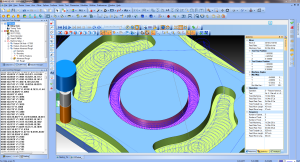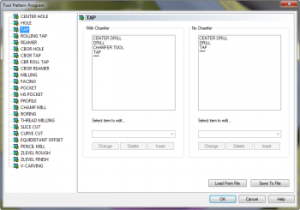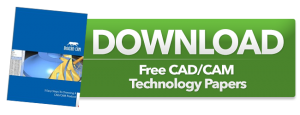 CAD-CAM software technology is a critical piece to keeping shops efficient and competitive. With all of the benefits that come with cnc software automation, we can’t help but look at the subject of “Feature-Based” machining. And so, is “Feature-Based” Machining just another CAM-Based term for Geometry-Machining?
CAD-CAM software technology is a critical piece to keeping shops efficient and competitive. With all of the benefits that come with cnc software automation, we can’t help but look at the subject of “Feature-Based” machining. And so, is “Feature-Based” Machining just another CAM-Based term for Geometry-Machining?
Almost every manufacturing CNC shop deals with solid models. Decades of CAD Design technology advancements have allowed designers to create models faster, smarter and easier than ever before. In fact, Parametric CAD modeling has allowed designers to collaborate and make changes far easier than even 10 years ago. This is because CAD model components that make up a model assembly contain the data necessary to edit and “update” complete assemblies within the blink of an eye. A decade ago there were few design products that offered such capabilities that included stress and heat analysis among other benefits. Today design systems allow you to collaborate freely, pass data back and forth from designer to designer with construction, feature and change histories including full detail as to what each component is. This is the future of innovation happening right now. But how does CAM take advantage of such power and flexibility? Is Feature Based CAM really Feature Based CAM? The answer is yes…..and no.
Features in CAD are not necessarily “features” in CAM machining. But at this level we are splitting hairs. Feature-based machining technology allows the programmer to set up the parameters ahead of time concerning holes, threaded holes, pockets and more. This can take a while but when it’s done it can be a real benefit. Particularly to shops that do a lot of the same types of parts or families of parts. These are basically “pre-set” parameters. Once these “defaults” are configured the programmer can open up the part file and assign machining features to geometry features. When it comes to holes this is clearly easy to define. Even 2D features in a model can be picked off relatively easy. Some would argue that what CAM people are calling “Feature-Based Machining” is really just “Geometry-Based Machining.” While that is a valid argument we don’t want to miss the fact that in CAM, there is what is called “Machining Features” that are basically strategies that are fully editable by the user and rightfully called “features.” We in CAM are all moving toward the day that a programmer can import a model and analyze all of the aspects of it so that an automated tool list can be created along with a pre-loaded CAM tree that is ready to go in terms of material used, facing, drilling, roughing, semi-finishing and finishing toolpath strategies all loaded and ready to simulate. Wouldn’t that be the ultimate in CAM automation integrating with parametric CAM? Currently CAM systems offer toolpath “associativity” allowing model edits to occur and toolpath updates to happen without much programmer input. Feature recognition technology in CAM has opened the door for conversations on “Feature-Based” machining yet it has primarily been hole drilling and 2D machining that has been affected.
So what do CAM people mean by Feature-Based machining? The ability to quickly and easily select features or geometry regions of a part model and assign them to a specific machining strategy or an editable machining “feature.” It’s really that simple. So how far does this go?
 Take CAM breakthroughs in “Tool Patterning” for example where you can define a drilling operation for multiple tools within one operation. A Tap feature is a good example where a center drill, drill, chamfer tool and a tapping tool may be needed (plus or minus the chamfer).
Take CAM breakthroughs in “Tool Patterning” for example where you can define a drilling operation for multiple tools within one operation. A Tap feature is a good example where a center drill, drill, chamfer tool and a tapping tool may be needed (plus or minus the chamfer).
Tool Patterns allow users to define these operations before using them in order to save time. A Feature-Based CNC CAD-CAM software would allow the user to completely set up all of their machining parameters ahead of time. Then the CNC software would automatically detect these areas and their associated machining operations and load everything up correctly to generate a g-code program. A lot of set up time is required to make this all happen smoothly. What about the job shop that does a lot of variety? Every job can be different in this case. Would this type of feature based machining be a big benefit? Maybe not due to the lengthy setup tasks. You would really have to weigh out the benefits.
Machinists and programmers should always have the freedom to choose what tools and machining strategies they would like to use. With that concept in mind, how about a new take on all of this that still gives the CAD-CAM software operator the ability to make choices without the need for major CAM parameter setups? For this level of CAM we will call it, “Dynamic Operations” whereas the programmer can rapidly select the CAD features in the model for specific machining strategies and then be able quickly load any of the available machining strategies for those features. This, without being limited in terms of what operations they want to use for any type of part that needs to be machined. The operator will simply choose what type of CAD feature they would like to machine, and then can choose any combination of Machining Operations to machine that one feature. Sort of like a CAD-CAM smorgasbord of time saving functionality for making chips out of the competition long term. Where the days of being limited to what comes with a specific machining strategy are gone. Maybe we ought to call this “Freedom CAM”.
When you are looking for your next CAM system, be sure to ask about this level of usability for CNC machining. You will be glad you did.
BobCAD-CAM has provided CAD-CAM CNC Software products to the global manufacturing industry for over 25 years. BobCAD-CAM software can be found to increase cnc productivity for many applications including educational and independent hobby-home use. BobCAD-CAM also provides a variety of quality training and technical support solutions to their customers. For more information on CAD-CAM CNC Software you can contact BobCAD-CAM directly at 877-262-2231 or 727-442-3554. You can also download a free CAD-CAM demo at www.bobcad.com.




Leave a Reply